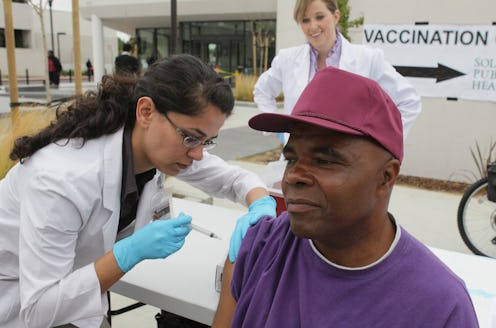News
More Women Than Men Enrolled In Med School In 2017 & There's Even More Good News

They say the future is female, and when it comes to medical science, that may now be truer than ever. Data released this week shows that this year, more women enrolled in medical school than men, that first time that's happened in U.S. history. According to data collected and released by the Association of American Medical Colleges (AAMC), women made up 50.7 percent of the 21,338 people who entered medical school in 2017, while men made up 49.8 percent.
"We are very encouraged by the growing number of women enrolling in U.S. medical schools," AAMC President and CEO Darrell G. Kirch, MD, said in a statement released earlier this week. "This year's matriculating class demonstrates that medicine is an increasingly attractive career for women and that medical schools are creating an inclusive environment. While we have much more work to do to attain broader diversity among our students, faculty, and leadership, this is a notable milestone."
Overall, the number of women medical school matriculates grew 3.2 percent from 2016 and a whopping 9.6 percent from 2015. By contrast, the number of male matriculates is on the decline. Enrollment among men declined 0.3 percent from 2016 to 2017, and has declined by 2.3 percent since 2015. Interestingly, more women were ultimately accepted and enrolled in medical school this year despite the fact that men made up a majority of the applicant pool, 50.4 percent.
But it isn't just the number of women matriculates that's on the rise. According to data from the AAMC, the number of minority medical school matriculates is also trending upward. For example, the number of black matriculates increased 12.6 percent from 2015 to 2017, while the number of matriculates of Hispanic, Latino, or Spanish descent rose 15.4 percent.
And as the AAMC pointed out earlier this week, while the class entering medical school in 2017 was both more diverse and more female, matriculates' experience and academic credentials remained "very strong." Not only did applicants' average GPA increase slightly, but 77 percent of applicants were found to already have research experience. Moreover, a total of 77 percent of applicants reported having completed volunteer community service in either a medical or clinical setting.
While entering medical school doesn't guarantee an individual will go on t become a doctor, greater representation among med school matriculates could lead to greater gender parity among doctors. Because even though female matriculates may outnumber their male counterparts in this year's medical school class, it's men who outnumber women in the field of licensed and practicing physicians. According to data released by the Henry J. Kaiser Family Foundation in October, men make up roughly 65.5 percent of the 951,061 physicians practicing in the United States. Women make up roughly 34.4 percent by comparison.
Some studies have shown patients may even stand to benefit from an increase in the number of women working as doctors. Past research has shown female doctors are more likely to order preventive tests and review patients' health practices and counsel them about any unhealthy behaviors.
Just last year, Harvard researchers found hospitalized elderly patients received better health results when cared for by a female doctor, too. In studying some 1.5 million hospital visits, researchers found hospitalized elderly patients treated by women were less likely to die or be readmitted after being discharged than those treated by male doctors. In fact, researchers argued doctors would save 32,000 lives a year if male doctors provided the same levels of care their female counterparts did.
Hopefully, the increased gender representation women are seeing now when it comes to medical school enrollment will lead to an increase in the number of female doctors working in the medical profession. And as we see more women take jobs as physicians, we'll see increased gender parity and higher levels of care.